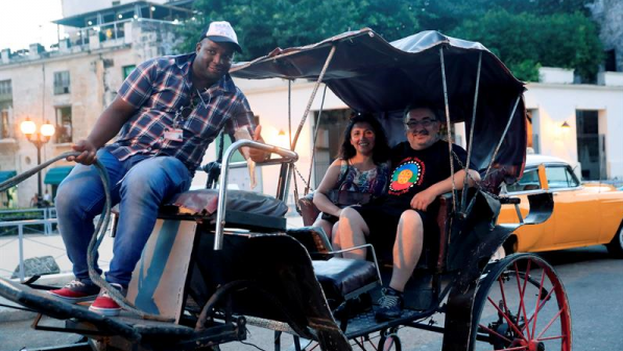
![]() 14ymedio, Madrid, 20 October 2022 — Three months after the end of the year, the goal of 2.5 million tourists that Cuba expected is confirmed as impossible. In the first nine months of 2022, 1,074,814 international travelers arrived on the Island, so in October, November and December, there must be 1.4 million more to reach the goal. Although the high season begins next month, the best figure of the year (152,480 in July) would have to triple in those three months to achieve it.
14ymedio, Madrid, 20 October 2022 — Three months after the end of the year, the goal of 2.5 million tourists that Cuba expected is confirmed as impossible. In the first nine months of 2022, 1,074,814 international travelers arrived on the Island, so in October, November and December, there must be 1.4 million more to reach the goal. Although the high season begins next month, the best figure of the year (152,480 in July) would have to triple in those three months to achieve it.
The Ministry of Tourism updated its data on Tuesday, with the publication in the National Office of Statistics and Information (Onei) of the arrival figures of travelers, including Cubans living abroad, through September. The figure reaches 1,553,461, an increase of roughly five-and-a-half times over the previous year. As for international visitors, discounting Cubans residing abroad, there were 1,074,814 in total, almost six times more than the 180,735 in 2021.
However, the Government is fooling itself again, since the 2021 figures are not comparatively useful. Although they do serve to measure the recovery of the sector after the pandemic, you have to put them in context with those of normal years for tourism, which between 2020 and 2021 plummeted worldwide due to covid-19. If you compare the data of international travelers between January and September of this year with those of 2019, 3,327,392, the difference is a decline of 68%. The contrast is even worse compared to the previous year, 2018, when 3,540,543 arrived. The decline in this case is 70%.
In detail, you can see how the collapse of Russian tourism is affecting Cuban accounts. The statistics break down the number of travelers from each country and compare it with the previous year, so in all cases it grows, given the closure of borders that was in force for much of 2021. Powerful examples are that of Canada, the first country to send tourists to Cuba traditionally, which increases from just 9,265 last year to 324,252 this year.
Cuban-Americans grew from 19,003 in 2021 to 240,197 in 2022, and the Spanish, at the head of European tourists, who as of September last year totalled 6,091, this year reached 62,157. This is repeated for all the main indicators, even for the catch-all category of “other.”
However, in the case of Russia, the figure completely reverses. In the first three quarters of 2021, 111,228 Russians arrived in Cuba, and this year in the same period barely 38,883 did so. In addition, as expected, almost all arrived until February, 35,871. At the end of that month, on the 24th, the invasion of Ukraine and the international sanctions on Russia began, which left many Russians unable to fly to certain destinations due to the ban on crossing European airspace.
This October, the Russian company Aeroflot resumed its flights to Havana, with routes bordering the North Pole to avoid the exclusion zone, so it’s possible that in the last quarter the numbers of tourists from that country will rebound, the only one that grew in visitors before the pandemic. The market, however, was showing symptoms of exhaustion already at the end of 2021, when the Island was reopened to travelers, and it was shown that the Russians had changed their preferences for the Dominican Republic, which with its strategy positioned itself at the forefront of Caribbean tourist destinations since it opened its borders in September 2021.
In recent months, the Cuban authorities are giving their all to recover one of the sectors that brings the most foreign exchange to their coffers, discounting remittances and “medical missions.”
This week the Health Tourism Fair takes place in Havana, where Cuba tries to sell all kinds of therapies and medical services with a view to the Caribbean. At the end of September, the XIII International Nature Tourism Event was held, in which an attempt was made to convince potential travelers that the Island is more than sun and beach. And also in the middle of last month, the Varadero Gourmet International Festival took place, which generated discomfort in the population for being a showcase of products that citizens can’t even dream of.
In all of them, Manuel Marrero, Prime Minister of Cuba, has supported the target of 2.5 million visitors, defending the idea that it will undoubtedly be achieved despite the difficulties. Months earlier, in May, the leader was the first to postpone the recovery of the sector to 2023, contradicting the rest of the Government and the minister of the branch, Juan Carlos García Granda.
“Next year the leisure industry will recover in Cuba, and for that purpose, the development of FitCuba 2022 will mark a before and after,” Marrero said then at another event in the sector, the Varadero Tourism Fair, to end up joining the official speech. Perhaps his thesis, that of a man who was Minister of Tourism for 15 years, should have prevailed.
Translated by Regina Anavy
____________
COLLABORATE WITH OUR WORK: The 14ymedio team is committed to practicing serious journalism that reflects Cuba’s reality in all its depth. Thank you for joining us on this long journey. We invite you to continue supporting us by becoming a member of 14ymedio now. Together we can continue transforming journalism in Cuba.
